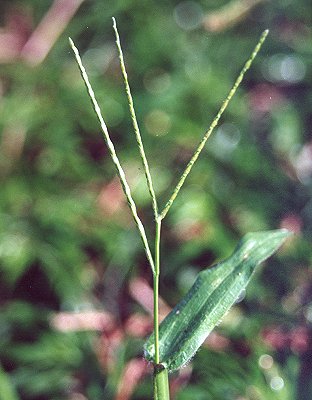 |
 |
|
 |
 |
|

Axonopus compressus (Sw.) P.Beauv. |
Common name
Broadleaf Carpet Grass
Derivation
Axonopus P.Beauv., Ess. Agrostogr. 12 (1812); from the Greek axon
(axis) and pous (foot), alluding to rachides arising from a common point
(digitate).
compressus- from the Latin comprimo (squeeze together), referring to the flattened culms.
Published in
Ess. Agrostogr. 154 (1812).
Habit
Perennial, mat forming. Stolons present. Young shoots flabellate. Culms decumbent,
15–60 cm tall. Mid-culm nodes pubescent. Ligule a fringed membrane, 0.4–0.6
mm long. Leaf-blades linear or lanceolate, flat or conduplicate, (1.5–)3–8(–250)
cm long, 3–12 mm wide. Leaf-blade apex obtuse or abruptly acute.
Inflorescence
Inflorescence digitate or subdigitate, with spicate branches. Spikes 2–5,
unilateral, 3–10 cm long. Central inflorescence axis 0–2 cm long.
Rhachis angular, glabrous on surface, glabrous on margins. Spikelet packing
adaxial, regular, 2-rowed.
Spikelets
Spikelets appressed, solitary. Fertile spikelets 2-flowered, comprising 1 fertile
floret, lower floret sterile, upper fertile, without rhachilla extension, lanceolate,
dorsally compressed, obtuse, 2–2.8 mm long, falling entire.
Glumes
Glume 1 (the lower absent or obscure), thinner than fertile lemma. Upper glume
lanceolate or elliptic or oblong or ovate, 2.1–2.8 mm long, 120–130%
of length of adjacent fertile lemma, 100% of length of spikelet, membranous,
4–5-nerved. Upper glume surface glabrous or pubescent, hairy between nerves.
Upper glume apex acute.
Florets
Basal sterile floret 1, without significant palea. Lemma of lower sterile floret
similar to upper glume, lanceolate or elliptic or oblong or ovate, 2.1–2.8
mm long, 100% of length of spikelet, 4–5-nerved, pubescent, hairy between
nerves, acute. Fertile lemma obovate, 1.5–2.4 mm long, indurate, pallid,
4-nerved. Lemma margins involute. Lemma apex obtuse, pubescent. Palea involute,
indurate.
Continental Distribution:
Africa, Temperate Asia, Tropical Asia, Australasia, Pacific, North America,
South America.
Australian Distribution:
Western Australia, Queensland, New South Wales.
Western Australia: Drummond, Menzies, Warren. Queensland: Cook, North Kennedy, South Kennedy, Port Curtis, Wide Bay, Moreton. New South Wales: North Coast, Central Coast.
Classification. (GPWG
2001):
Panicoideae: Paniceae
Notes
Introduced. Native to the tropics and subtropics of North America, but is now
widespread throughout the tropics of the world. It is a weedy species but makes
a suitable lawn grass. Flowers Jan.–May.

Inflorescence (photo)
© B. Hacker